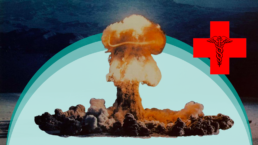Advocates are working to expand and extend legislation that provides one-time compensation for victims of radiation exposure before the bill expires next July
By Tamar Sarai Davis, Prism
Claudia Peterson’s childhood in Hamilton Fort, Utah, was replete with many of the trappings typical of a small farm community. She and her siblings grew up with a large garden and cared for chickens, pigs, and a cow. Her neighbors herded sheep, and she always looked forward to playing with their baby lambs. But all around there were also small hints that not everything was as normal or idyllic as it appeared.
There were the piles of dead, deformed lambs she came across one year. Potassium iodine pills were distributed to her sister’s class after—not before—a nearby nuclear test was administered, and she and her classmates were given routine Geiger counter tests.

”There were two or three of us in the class that lit it up and we were kind of excited,” recalled Peterson. “We [asked] what that meant and they [told] us it was for dental X-rays.”
Then people around her started getting sick and dying. As a child, Peterson lost classmates to cancer. When she was a young adult, her father died of a stroke three months after he had surgery to remove a brain tumor. And then Peterson’s young daughter Bethany was diagnosed with stage 4 cancer while Peterson’s sister discovered she had melanoma.
Recent Posts
‘Unconstitutional. Unethical. Authoritarian.’ ICE Bars Millions Of Immigrants From Bond Hearings
July 18, 2025
Take Action Now One watchdog said the new policy “seems like a blatant attempt to stop them from exercising their right to due process.”……
Americans Are Not Nearly Alarmed Enough About Climate Change
July 18, 2025
Take Action Now Americans still don’t comprehend how imminent, dangerous, and far-reaching the threat is—and journalists are partly to blame.By…
The IRS Is Building A Vast System To Share Millions Of Taxpayers’ Data With ICE
July 17, 2025
Take Action Now ProPublica has obtained the blueprint for the Trump administration’s unprecedented plan to turn over IRS records to Homeland Security…
Israel’s Sudden Assault On Syria Is Unchecked Aggression
July 17, 2025
Take Action Now Jerusalem is bombing Damascus and threatening al-Sharaa’s rule, while Washington was hoping to help the nascent government on…




